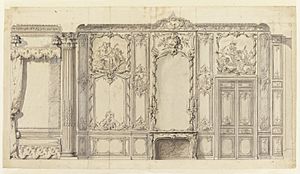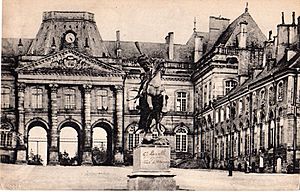Germain Boffrand facts for kids
Germain Boffrand (born May 16, 1667 – died March 19, 1754) was a famous French architect. He learned from Jules Hardouin-Mansart, another well-known architect. Boffrand was key in creating a style called style Régence, which came before the Rococo style. He also helped shape the Rococo style itself, especially in the inside designs of buildings.
For the outside of buildings, he stuck to a grander, more classic style called Late Baroque. But he also added new ideas to how spaces were planned, which was quite unusual in France. His most important projects, like the beautiful interiors of the Hôtel de Soubise, were written about in his book, Livre d'architecture, published in 1745. This book helped spread the French Louis XV style across Europe.
Contents
Life and Work

Germain Boffrand was born in Nantes, France. His father was also an architect. In 1681, young Boffrand moved to Paris to study sculpture. He then joined the large architecture office of Jules Hardouin-Mansart. His uncle, Philippe Quinault, helped him meet important people who became his clients.
From 1689, Boffrand worked on royal building projects. These included the Orangerie at the Palace of Versailles and the Place Vendôme in Paris. He helped with the first designs for Place Vendôme.
In 1699, he left the royal projects to work for private clients. He first worked in Lorraine and the Netherlands. After returning to Paris in 1709, he designed buildings for wealthy families. These clients liked his bold new ideas. For example, he designed an oval courtyard for the Hôtel Amelot de Gournay (1710–13). Such new ideas were not allowed in royal buildings.
In 1709, Boffrand took charge of the inside designs for the Hôtel de Soubise. He later created the amazing Rococo designs there after 1735.
Important Roles and Projects
Boffrand became a member of the Académie royale d'architecture in 1709. The next year, he helped with additions to the Palais Bourbon. In 1732, he became the chief inspector for bridges and roads. He also made plans to redesign Les Halles, a large market in Paris.
He took part in a competition to design the Place Louis XV. In 1724, he became the chief architect for the main hospital system. He built a hospital for foundlings (abandoned children) in Paris. Boffrand also worked on other hospitals like Salpêtrière and Hôtel-Dieu.
He built several large private houses, called hôtels particuliers, as business projects. One of these, the Hôtel Amelot de Gournay, had very clever room layouts. A writer named Germain Brice said its designs were "remarkable and daring."
Work Outside Paris
Boffrand also worked for the Duke of Lorraine. He was named the Duke's main architect in 1711. He also built a fountain and a hunting lodge in Bavaria for the Elector Maximilian II Emmanuel.
In 1724, Boffrand worked with Balthasar Neumann at the Prince-Bishop's Residenz in Würzburg, Germany. Boffrand's designs influenced the main rooms there.
Some famous architects learned from Boffrand. These included François Dominique Barreau de Chefdeville and Emmanuel Héré de Corny. Héré de Corny later designed the famous Place Stanislas in Nancy.
Later Life and Death
Boffrand's important book, Livre d'architecture, was published in 1745. In January 1745, he was chosen as a Fellow of the Royal Society in London. Germain Boffrand passed away in Paris in 1754 at the age of 86.
Key Buildings and Designs
Here are some of the important buildings Boffrand designed or worked on:
In Paris
- Hôtel Le Brun (1700): One of his first private houses, praised by critics.
- Hôtel de Soubise (1704–1707, interiors 1735–1740): This is considered his masterpiece. It now houses the French National Archives.
- Façade of the Convent of Fathers of Mercy: Built across from the Hôtel de Soubise.
- Hôtel d'Argenson (1704): Used as a government office later.
- Hôtel Petit-Luxembourg (1709–1716): He renovated this for a princess. Much of his decoration, like the staircase, can still be seen.
- Hôtel de Mayenne (1709): He transformed this building.
- Hôtel Amelot de Gournay (1712): One of his smart business projects.
- Hôtel de Beauharnais (1714): Now the German Embassy.
- Hôtel de Seignelay (1713): Next to the Hôtel de Beauharnais.
- Bibliothèque de l'Arsenal (1715–1725): He designed new apartments here for the duc du Maine.
- Palais de Justice (1722): He did restoration work here.
- Hôtel de Villars: He designed the entrance doorway. It is now a local town hall.
In the Parisian Region
- Château de Roissy-en-France (1704–1715): A large castle, now destroyed.
In Picardie
- Château de Bertangles (1730–1734): A beautiful castle built for a noble family.
In Lorraine
- Château de Lunéville (1708–1709): Built for the Duke of Lorraine. It was damaged by fire in 2003.
- Château de Commercy: Another castle for a prince.
- Château de La Malgrange (1711–1715): Near Nancy, now destroyed.
- Palais d'Haroué (1720–1732): Built for a prince.
- Hôtel Ferraris (1717–1720): A private house in Nancy.
- Hôtel de Craon (1717–1720): Also in Nancy, for the prince of Craon.
Religious Buildings
- Chapelle de la Communion de l'Église Saint-Merri (1743): A chapel in Paris.
- High altar of the cathedral of Nancy: He continued this project after Mansart's death.
- High altar of the cathedral of Nantes.
- Notre-Dame de Paris: He helped restore parts of this famous cathedral, including a large rose window and some chapels.
Civil Engineering (Bridges)
- Bridge (the Pont-Vieux) of Pont-sur-Yonne.
- Bridge of Joigny (Yonne), 1725–1728.
- Bridge of Villeneuve-sur-Yonne (Yonne), 1735.
See also
 In Spanish: Germain Boffrand para niños
In Spanish: Germain Boffrand para niños




